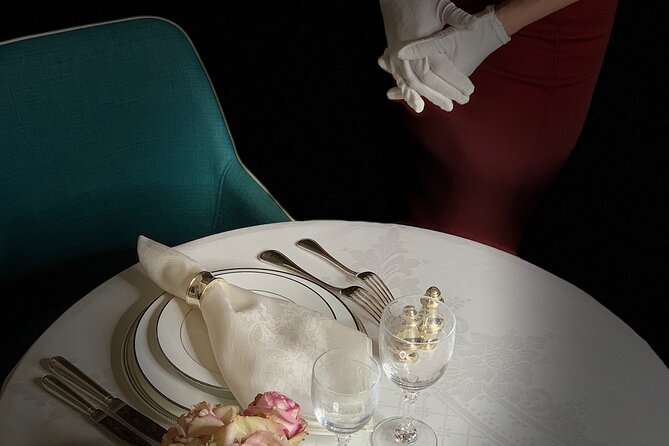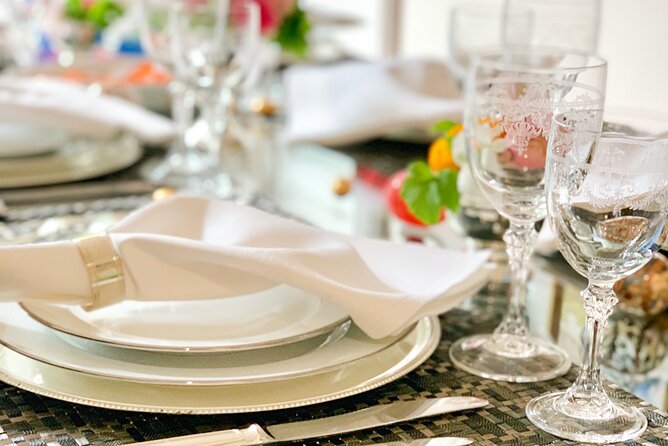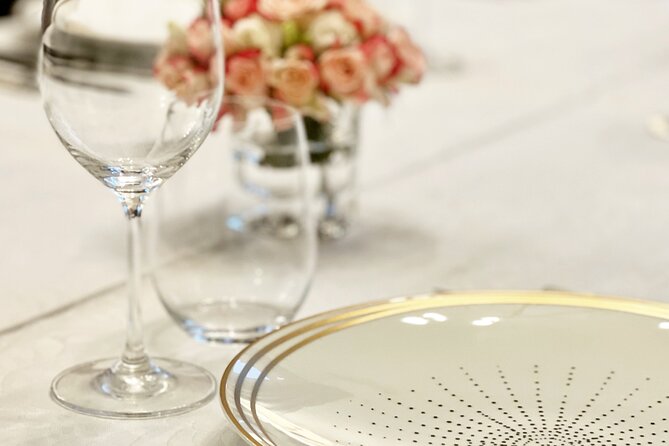Like an intricate dance choreographed with precision, French table manners exude an air of sophistication and cultural significance. The art of dining a la Française goes beyond mere etiquette; it embodies a profound connection between food, tradition, and social interactions.
As one delves into the world of French dining customs, a rich tapestry of unwritten rules and nuances unfolds, offering a tantalizing glimpse into the intricate world of French gastronomy. Join this exploration of timeless traditions and modern trends that define the essence of French dining sophistication, and discover the secrets behind the impeccable table manners that characterize French culinary excellence.
Key Points

- French table manners reflect centuries of cultural evolution and tradition.
- Etiquette in French dining signifies respect, social cohesion, and cultural importance.
- French dining culture emphasizes multiple courses, wine pairings, and savoring food and company.
- Modern French table etiquette blends tradition with innovation, embracing diverse cuisines and sustainability.
History of French Table Manners

French table manners have evolved over centuries, reflecting the rich culinary and cultural history of France. Evolutionary changes in French table manners can be traced back to the Middle Ages when elaborate feasts and banquets were common among the aristocracy.
The Renaissance period brought a refinement to dining etiquette, introducing the concept of using utensils and individual place settings. Cultural influences, such as the reign of Louis XIV, further shaped French dining customs, emphasizing elegance and sophistication in table manners.
The French Revolution marked a shift towards simpler and more egalitarian dining practices, making a significant impact on how meals were shared and enjoyed. These historical events have contributed to the unique blend of tradition and refinement that characterizes modern French dining etiquette.
You can also read our reviews of more tours and experiences in Paris.
Importance of Etiquette in France

As dining customs in France have evolved through various historical periods, the emphasis on proper etiquette remains a fundamental aspect of French culture and social interactions. French culture places significant importance on dining etiquette, shaping the way individuals interact and dine together. Understanding and practicing proper manners at the table is seen as a sign of respect for both the food being served and the company present. This emphasis on etiquette extends beyond just dining; it reflects a deeper appreciation for tradition, refinement, and social harmony within French society.
-
Symbol of Respect: Observing dining etiquette in France is a way to show respect for the host, the food, and the dining companions.
-
Cultural Signifier: Proper manners at the table are viewed as a cultural signifier, reflecting an individual’s upbringing and social awareness.
-
Social Cohesion: Following dining etiquette fosters social cohesion and strengthens interpersonal relationships within the French community.
Key Differences in French Dining
When dining in France, one can immediately notice the subtle yet significant differences in table manners compared to other cultures. French cuisine is not only about the food but also about the dining culture that accompanies it. Here are some key differences in French dining:
| Aspect | Description |
|---|---|
| Meal Structure | Meals in France typically consist of multiple courses, starting with an appetizer. |
| Bread Etiquette | Bread is placed directly on the table, not on the plate, and is used to mop up sauces. |
| Wine Pairing | French dining often incorporates wine pairings with each course. |
| Slow Pace | Meals are enjoyed slowly, with breaks between courses to savor the food and company. |
Traditional Dining Customs in France
Amidst the rich tapestry of French dining customs, a particular emphasis is placed on the art of savoring each dish and engaging in lively conversation around the table.
-
Meal Structure: French dining traditions often involve multiple courses, starting with an apéritif, followed by entrée, plat principal, cheese, dessert, and ending with coffee.
-
Table Etiquette: Cultural customs dictate that hands should be kept visible on the table, wrists resting on the table edge, and cutlery held in a specific manner.
-
Wine Pairing: Pairing food with the appropriate wine is essential in French dining traditions, with each dish having a recommended wine to enhance the flavors.
These customs reflect the French reverence for food, conversation, and shared experiences around the dining table.
Modern Trends in French Table Etiquette

Modern French table etiquette evolves with contemporary influences, reflecting a blend of tradition and innovation in culinary customs.
In contemporary dining settings, cultural influences play a significant role in shaping how the French approach mealtime etiquette. One trend is the fusion of diverse cuisines, leading to new ways of presenting and consuming food.
This modern approach to dining often encourages a more relaxed atmosphere, where sharing dishes and engaging in lively conversations are valued.
Plus, sustainability and eco-conscious practices have become integral to French dining etiquette, with an emphasis on locally sourced ingredients and reducing food waste.
These evolving trends in French table etiquette showcase a dynamic shift towards embracing new culinary experiences while still honoring the rich traditions of gastronomy.
- Famous Graves of Père Lachaise Cemetery Guided Tour
- Closing Time at the Louvre: the Mona Lisa at Her Most Peaceful
- Eating Paris: Montmartre Food & Wine Tour
- Private Transfer From CDG or ORY Airport to PARIS City
- Private Guided Professional Photoshoot by the Eiffel Tower
- Paris Catacombs Skip the Line Guided Tour
Common questions

What Are Some Common Mistakes to Avoid When Dining in France?
When dining in France, it’s crucial to be aware of cultural differences. Understanding dining etiquette is key to a positive experience. Common mistakes to avoid include placing hands on the table, splitting the bill, and not saying "bon appétit".
Are There Any Specific Rules Regarding Tipping in French Restaurants?
When dining in French restaurants, tipping customs are important to know. In France, service charges are usually included, but it’s common to leave a small additional tip for exceptional service. Meeting service expectations ensures a pleasant dining experience.
How Can One Politely Decline a Dish or Beverage in a French Dining Setting?
In a French dining setting, one can politely decline a dish or beverage by expressing their dietary restrictions or cultural sensitivity. Non-verbal cues like a gentle refusal gesture can also convey politeness while respecting the host’s offering.
Is It Acceptable to Ask for Substitutions or Modifications to a Dish in French Restaurants?
In French restaurants, it is generally acceptable to request substitutions or modifications to accommodate dietary restrictions. However, it’s essential to be mindful of cultural expectations and etiquette when making such requests to ensure a pleasant dining experience.
What Is the Appropriate Way to Address the Server or Waiter in a French Dining Establishment?
In French dining establishments, it’s customary to address servers with "Monsieur" or "Madame." Greeting etiquette is important to show respect. Be mindful of language barriers and cultural differences, but customer service in France values politeness and formality.
Final Words

To sum it up, mastering the art of French table manners isn’t just about following rules, but embracing a cultural tradition that symbolizes elegance and sophistication.
Understanding the history and importance of etiquette in France allows us to appreciate the unique dining customs and traditions that have shaped the French culinary experience.
By exploring both traditional practices and modern trends in French table etiquette, we gain a deeper insight into the profound connection between food, culture, and social interactions in France.
More Tour Reviews in Paris
Not for you? Here's more nearby things to do in Paris we have reviewed
- Paris, Latin Quarter Walking Tour With Audio Guide
- Loire Valley Castles Day Trip With Audio Guided Option From Paris
- Emily in Paris Guided Walking Tour
- Vows Renewal Ceremony With Photoshoot – Paris
- Private Van Transfer From CDG to Airport Beauvais
- Paris: Covered Passages Audio-Guided Walking Tour
- Paris: Luxury Mercedes Transfer to Bayeux
- Best of the Louvre Museum Private Tour With Monalisa
- Paris: Romantic Montmartre Exploration Game
- Paris: Eiffel Tower Tour & Seine Champagne Cruise Combo
- Versailles Private Round-Trip Luxury Transfer From Paris
- Paris Like a Local: Le Marais Self-Guided Tour in a Bag
